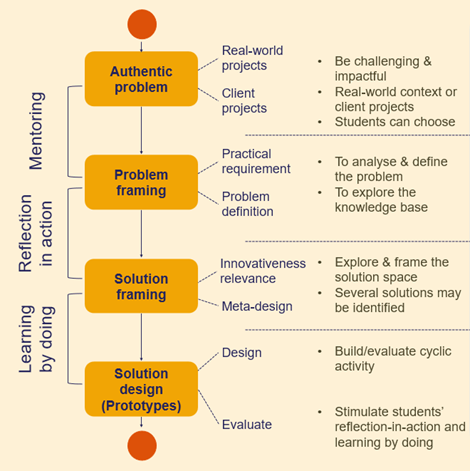
A framework for teaching work integrated learning projects

Work integrated learning (WIL) is a pedagogical approach that helps to prepare students for work and life by enabling them to apply what they have learned during their academic studies in a workplace context. WIL is therefore incorporated into most undergraduate programmes and helps to familiarise students with professional practice, fosters industry engagement and develops graduate employability. But what steps can we follow to structure WIL projects so they train students in the problem solving and creative thinking they are likely to need in the workplace?
We use design science, which seeks to enhance human knowledge via the creation of innovative artefacts or solutions, for structuring WIL projects across different courses, using the lecturers’ experience and insights. We found that four key elements make up an effective framework for teaching WIL projects:
- Establishing an authentic problem;
- Framing the problem;
- Framing the solution;
- Designing the solution

Authentic problem
To start, students should identify an authentic problem in which they are interested. Our experience shows that allowing students to select their own problems to work on leads to better engagement in the project. But lecturers must make sure the problem chosen is challenging, impactful and grounded in a real-world context. Examples of authentic problems identified by students include “negative impacts of humans on the environment”, and “seeking to improve healthy lifestyles”.
To help students explore the authentic problem, we can:
- Introduce students to real-world challenges that are relevant to the course;
- Invite guest speakers to talk about current difficulties in the field;
- Invite industry partners to become the project clients;
- As a lecturer, share previous successful WIL projects;
- Allocate mentor times for the whole class or groups of students to consult on their WIL projects.
Problem framing
Problem framing is crucial to gaining a proper understanding of the problem by analysing it and coming up with clearer, more focused, definition. It helps students to understand that problems can be ill-defined, do not immediately lead to expected outcomes, and can be symptomatic of other problems.
During problem framing, students identify a set of constraints, requirements, causes and effects, all of which further define the problem. A starting point is to look at the cause-effect relationship, so, for example, for “negative impacts of humans on the environment”, the problem may, in part, be caused by low levels of recycling. This means that the problem can be framed as “negative impacts of humans on the environment due to a failure to recycle more”. Constraints might be related to a specific demographic or location, where recycling levels are particularly low and look at possible reasons. So, the focus then turns to how to solve the problem within this more focused framework, rather than a very broad problem with no one practical solution.
Once students have specified their problem, here are some tips to help them frame it:
- Ask students to interview relevant project “clients” for their pain points and the impacts of the problem on their lives or their businesses. In some cases, other students may play the client role in the interviews
- The Six Thinking Hats technique, which encourages students to consider a problem from different angles, can be used;
- Ask students to construct an empathy map, which offers a visualisation of how different groups may be affected by the problem;
- Encourage students to discuss the problem in groups;
- Encourage students to share their problem framing with the class and gather feedback.
Solution framing
Next, students should explore and frame satisfactory solutions for the problems. As there are always multiple potential solutions for a defined problem, several solutions may be identified and described during solution framing. Regarding the environmental recycling problem, for instance, students may explore the idea of “smart” recycling bins that can talk to people in order to encourage proper recycling behaviours, or recycling bins that can detect when they are full and autonomously move to empty themselves. Students should consider the expected properties, requirements and values of the identified solutions, in order to contextualise and justify their chosen solutions. Taking the smart recycling bins as an example, a key property to consider would be their default language; a requirement would be that the bins must adhere to required recycling rules in the country or region; a value would be that it must increase recycling rates.
Steps to enhance solution framing include:
- Encourage students to propose multiple solutions;
- Ask them what-if questions regarding expected properties, requirements or values of the identified solutions;
- Encourage students to search for relevant solutions from other disciplines;
- If students already have one solution, ask for alternatives;
- Encourage students to improve upon existing solutions.
Solution design
The framework finishes with solution or artefact design, which involves a cyclic design-evaluate activity. Ask students to design a prototype for their solutions and evaluate it. One way is to perform an in-class demonstration, where students show the prototype and explain how it addresses the problem. This can be done using a variety of techniques, such as storytelling, storyboarding and role-playing. They can then refine and improve their solution according to the class response and feedback. This cycle stimulates reflection-in-action and learning by doing. The project does not need to result in a complete and perfect solution but a proof of concept. Examples relating to the smart recycling bin include a prototype application to support the talking functions, an interactive interface for the bin, or a video showing a small-scale recycling bin autonomously moving to empty itself. These proofs of concept help demonstrate the feasibility of the solution, and how they will help boost recycling levels.
Here are some tips for prototyping:
- Introduce students to different digital design tools that can support prototyping, including Figma, Evolus Pencil or Justinmind Prototyper;
- Let students choose their prototype tools;
- In-progress evaluation during the prototype building process is helpful from peers and any relevant industry partners acting as clients for the project;
- Multiple cycles of build and evaluate can be completed.
These tips to improve the teaching WIL projects, based on design science, should be adapted to different university courses to ensure maximum impact on students’ learning and satisfaction.
Nguyen Hoang Thuan is senior programme manager for digital business at the School of Business and Management, RMIT University Vietnam. Pedro Antunes is associate professor in University of Lisbon, Portugal.
If you found this interesting and want advice and insight from academics and university staff delivered direct to your inbox each week, sign up for the THE Campus newsletter.


